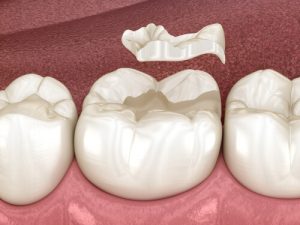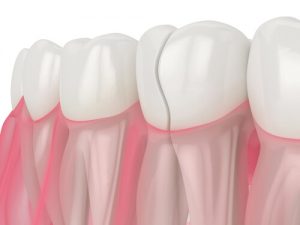Searching for a reliable solution is paramount when a cracked tooth becomes a source of discomfort. The use of a molar band for cracked tooth presents an intriguing option. This method, often suggested by dental professionals, aims to encapsulate and protect the tooth from further damage while providing a pathway to healing.
But how exactly does it work, and what can patients expect during and after the procedure? Join us as we delve into the mechanics and benefits of using a molar band for cracked teeth, uncovering why it might be your desired answer.
Introduction to Molar Bands: What Are They?
Orthodontic band placement is a crucial step in dental and orthodontic care, particularly when dealing with the stability and support of teeth that may be compromised. Often, a stainless steel band made from stainless steel encircles the tooth, providing a secure platform for attaching other orthodontic devices or reinforcing the structure of a tooth at risk, such as a cracked tooth.
- Structure and Material: Molar bands are typically crafted from durable materials like stainless steel, which can withstand the daily pressures of biting and chewing without breaking.
- Application in Dental Treatment: They are commonly used in orthodontics to anchor braces and other hardware, but they are also employed in general dentistry to support teeth that are weak or have large fillings.
- Cracked Tooth Prevention and Support: For teeth with minor cracks, molar bands help distribute biting pressure across the tooth, preventing cracked teeth from worsening and offering a preventive measure against potential tooth fractures.
- Therapeutic Uses: In cases where a tooth has suffered from more extensive damage, such as cracked tooth syndrome, a molar band can stabilise the tooth until more definitive treatments like root canal therapy or crowns can be applied.
The Role of Molar Bands in Treating Cracked Teeth
Molar bands are an essential tool in the dental care arsenal, particularly when addressing the complex issue of cracked teeth. These metal bands are designed to encircle a tooth, offering support and stabilisation, which is crucial in effectively managing and treating cracks in teeth.
- Stabilisation of the Tooth Structure: Molar bands help stabilise the tooth by encircling it and distributing the force exerted on it more evenly. This is particularly beneficial for teeth with trauma or large fillings, as it prevents the crack from spreading further.
- Prevention of Tooth Fragmentation: By providing a secure hold around the affected tooth, molar bands prevent the segments of a cracked tooth from moving independently. This is crucial in preventing the tooth from fragmenting, which can lead to tooth loss.
- Foundation for Further Treatment: Molar bands are an excellent foundation for further therapeutic procedures. They are often used temporarily to hold the tooth together while preparations are made for more permanent treatments such as crowns or root canal therapy.
- Alleviation of Symptoms: Applying a molar band can significantly reduce symptoms associated with cracked teeth, such as sharp pain when biting down or sensitivity to temperature changes. By securing the teeth’ cracked sections, molar bands help alleviate discomfort, allowing normal function while the tooth is being treated.
Benefits of Using Molar Bands for Dental Repairs
 Molar bands are highly beneficial for dental repairs, particularly for stabilising and protecting compromised teeth. Here are the primary advantages of using molar bands in dental treatments:
Molar bands are highly beneficial for dental repairs, particularly for stabilising and protecting compromised teeth. Here are the primary advantages of using molar bands in dental treatments:
- Support for Dental Restorations: They are often used in conjunction with other dental procedures, such as bracing or applying crowns. Molar bands offer a reliable anchor point for these restorations, ensuring they stay in place and function effectively.
- Prevention of Tooth Decay and Damage: By fitting snugly around the tooth, molar bands help shield the underlying tooth from exposure to decay-causing bacteria and food particles. This barrier can significantly reduce the risk of cavities and decay in areas that are difficult to clean, such as the back molars.
- Longevity of Dental Work: The support provided by molar bands can extend the life of dental restorations. For instance, orthodontics helps maintain braces’ alignment, leading to more successful long-term outcomes for patients undergoing teeth straightening procedures.
- Minimisation of Tooth Movement: In cracked or damaged teeth cases, molar bands minimise the movement of the affected tooth’s parts. This stabilisation is essential for preventing pain and discomfort associated with a cracked tooth and allows natural healing processes to occur more effectively.
- Cost-Effectiveness: Molar bands are a cost-effective solution for various dental issues. They can prevent the need for more invasive and expensive treatments by addressing potential problems early and maintaining overall tooth health.
How Molar Bands Are Fitted: A Step-by-Step Guide
Fitting large filling with a molar band is a precise process that requires professional expertise to ensure it’s done correctly and comfortably. Here’s a step-by-step guide to the process of how molar bands are typically fitted in a dental setting:
- Initial Examination and Cleaning: The dentist thoroughly examines the teeth to determine the suitability of a molar band. The tooth where the band will be placed is cleaned meticulously to remove any plaque or debris, ensuring the band adheres properly.
- Selection of the Correct Band Size: Dentists have a variety of molar band sizes available. They will select the one that most closely fits the tooth’s shape and size. This is crucial for comfort and effectiveness. The band must be snug but not too tight, as it needs to fully encircle the tooth without causing undue pressure or discomfort.
- Fitting the Band: The selected band is carefully slipped around the tooth. This is usually done manually by the dentist, who will gently manipulate the band around the tooth until it sits just below the gum line. Specialised tools may be used to adjust the band’s position and ensure it fits evenly around the entire circumference of the tooth.
- Securing the Band: It may be secured using dental cement or another adhesive once properly positioned. This helps to keep the band firmly in place, preventing it from moving or slipping during daily activities such as eating or brushing.
- Adjustment for Comfort: The dentist will check the fit and make necessary adjustments to ensure the band does not impinge on the gums or neighbouring teeth. The patient may be asked to bite down or speak to ensure the band causes no discomfort or obstruction.
- Final Inspection and Instructions: After fitting, the dentist conducts a final inspection to ensure everything is secure and comfortable. They will provide the patient with instructions on caring for the molar band, including how to clean it and what foods to avoid to prevent damage.
- Follow-Up Appointments: Follow-up visits may be scheduled to monitor the band and make adjustments if necessary. This is particularly important in orthodontic treatments where molar bands are used as bracing anchor points.
Potential Complications and How to Avoid Them
 While molar bands are useful in dental and orthodontic treatments, they can sometimes lead to complications. Here’s an overview of common issues and strategies for avoiding them:
While molar bands are useful in dental and orthodontic treatments, they can sometimes lead to complications. Here’s an overview of common issues and strategies for avoiding them:
Gum Irritation and Infection: Molar bands can irritate the gums, leading to discomfort or infection. Ensuring that the band is properly fitted and tight enough is crucial. Regular dental check-ups allow adjustments and early diagnosis and intervention if irritation occurs.
Tooth Decay Under the Band: If the mouth is not sealed correctly, food particles and bacteria can become trapped under a molar band, causing decay. Maintaining excellent oral hygiene, including thorough brushing around the band and using fluoride rinses, is essential.
Loosening or Displacement: Molar bands can loosen or displace themselves, reducing their effectiveness and causing discomfort. To prevent this, avoid chewing hard foods and candies that can dislodge the band and check its stability regularly.
Allergic Reactions: Some patients might be allergic to the metals used in molar bands, such as nickel. Patients should inform their dentist about metal allergies and consider alternative materials like ceramic or composite bands.
Increased Plaque Accumulation: Molar bands can hinder effective tooth cleaning, leading to increased plaque buildup and gum disease. It is recommended that you use specialised cleaning tools such as water flossers or orthodontic brushes to thoroughly clean around and under the bands.
Resorption of Tooth Root: In rare cases, prolonged pressure from poorly fitted molar bands can lead to tooth-root resorption. Regular dental appointments are crucial to verify the proper fit of the band and to keep track of the health of the teeth and surrounding tissues.
Comparing Molar Bands to Other Dental Restoration Options
 Molar bands are one of several dental restoration options for treating and managing various dental issues. Comparing them to other alternatives can help patients and dental professionals choose the most suitable method for specific dental needs. Here’s a look at how molar bands stack up against other common dental restoration techniques:
Molar bands are one of several dental restoration options for treating and managing various dental issues. Comparing them to other alternatives can help patients and dental professionals choose the most suitable method for specific dental needs. Here’s a look at how molar bands stack up against other common dental restoration techniques:
Molar Bands vs. Dental Crowns
- Molar Bands are primarily used as a temporary stabilisation tool or as part of orthodontic treatment to anchor braces. They encircle the tooth, providing support without covering the entire tooth surface.
- Dental Crowns fully encapsulate the tooth above the gum line, offering protection and strength to a damaged or decayed tooth. Crowns are a permanent solution designed to restore a tooth’s function and aesthetics more comprehensively than molar bands.
Molar Bands vs. Fillings
- Molar Bands do not address the issue of decay directly but can prevent further damage to teeth at risk of fracturing.
- Fillings are employed to fix minor to moderate tooth decay. The material is placed directly into cavities to restore the tooth’s integrity. Fillings can be made from composite, amalgam, or porcelain materials and are less invasive than crowns.
Molar Bands vs. Onlays and Inlays
- Molar Bands provide circumferential support and are often used temporarily.
- Onlays and Inlays are custom-made indirect fillings fitted to a tooth with too much damage for a standard filling but insufficient to require a crown. Onlays envelop one or more cusps of a tooth, while inlays fit within the cusps. Both are made from durable materials like porcelain or composite resin, providing a long-lasting restoration without full coverage.
Molar Bands vs. Veneers
- Molar Bands are not used for aesthetic enhancements but for structural integrity and orthodontic purposes.
- Veneers are slender layers of porcelain or composite material covering the teeth’ front surface, primarily used to improve dental appearance. They are an aesthetic solution, not typically used for therapeutic purposes like molar bands.
Molar Bands vs. Dental Implants
- Molar Bands temporarily support existing teeth.
- Dental Implants are a permanent replacement for a missing teeth from the roots up to the crown. Implants give a foundation for replacement teeth that look, feel, and function like natural teeth.
Maintenance Tips for Molar Bands
Properly maintaining molar bands is essential to ensure their effectiveness and prevent additional dental issues like decay or gum disease. Here are some essential maintenance tips for those with molar bands:
- Regular Cleaning: It’s crucial to keep the area around the molar band clean. Brush daily with a soft toothbrush, paying special attention to the area around the band. This helps get rid of plaque and food particles that accumulate under and around the band.
- Use an Interdental Brush: A regular toothbrush might not reach all the nooks around the molar band. An interdental brush can help clean those hard-to-reach areas effectively, preventing plaque buildup.
- Floss Carefully: Flossing around a molar band can be challenging but is necessary to prevent gum disease and decay. Use waxed floss or a floss threader to navigate around the band and between the teeth without causing damage to the band or irritation to the gums.
- Rinse with an Antiseptic Mouthwash: Rinsing with an antiseptic mouthwash can help kill bacteria that might accumulate around the molar band. It’s an excellent supplement to brushing and flossing, especially if you find those activities challenging with a molar band.
- Avoid Sticky and Hard Foods: Chewing sticky or hard foods can dislodge or damage molar bands. Avoid candies, gum, nuts, and seeds, which can get stuck and pull on or break the bands.
- Regular Dental Check-Ups: Schedule regular dental appointments for examinations. Your dentist can oversee the status of the molar band as well as the adjacent teeth and gums. They can also perform professional cleaning to remove any plaque buildup you might have missed during home care.
- Be Mindful of Discomfort: If you experience any pain or discomfort in the area of the molar band, consult your dentist. Pain might indicate that the band has shifted, or decay or gum disease may develop.
When to Consider a Molar Band for Your Cracked Tooth
 Deciding when to consider a molar band for a cracked tooth involves understanding the specific circumstances and severity of the crack. Here’s when a molar band might be recommended:
Deciding when to consider a molar band for a cracked tooth involves understanding the specific circumstances and severity of the crack. Here’s when a molar band might be recommended:
Moderate to Severe Cracks: If the crack in your tooth is more than just a superficial line and extends into the dentin or near the gum line, a molar band can help stabilise the tooth. It prevents further damage by distributing biting pressure more evenly.
Tooth with Large Fillings: Due to their weakened structure, teeth with large fillings are more vulnerable to cracks. A molar band can provide additional support to these teeth, reducing the risk of cracking further and avoiding the need for more invasive procedures like crowns or root canals.
Early Signs of Tooth Fracture: When a fracture is treated early, especially when parts of the tooth remain intact and functional, a molar band can act as a preventative measure to hold the tooth together and prevent the crack from worsening.
Following Root Canal Treatment: After a root canal, teeth, particularly molars, can become brittle and more susceptible to fractures. A molar band can provide the necessary support to keep the tooth intact as it endures chewing forces.
Teeth Subject to High Stress: If your teeth are subject to high biting forces, perhaps due to your bite alignment or habits like bruxism (teeth grinding), a molar band might be advised to protect them from developing or exacerbating cracks.
Before Comprehensive Orthodontic Treatment: In some orthodontic cases, particularly where there is a risk of applying stress to a cracked tooth during treatment, a molar band might be used to secure the tooth beforehand, ensuring it does not suffer further damage during the orthodontic procedures.
If you’re struggling with a cracked tooth, a molar band might be the ideal solution to alleviate pain and prevent further damage. This method offers a stable and effective way to restore the integrity of your tooth. Consult with your dentist to see if a molar band for the cracked tooth suits you and embark on a healthier, pain-free smile.
If you’re experiencing discomfort from a cracked tooth and think a molar band might be the solution, don’t wait to get the help you need. Call us now at (08) 9783 9006 Emergency Dentist Perth to schedule a consultation. Our team is ready to assist you with effective and prompt dental solutions to most cracked teeth to restore your smile and relieve pain.
References
Cracked Teeth
https://www.teeth.org.au/cracked-teeth
Characteristics of Cracked Teeth with Reversible Pulpitis After Orthodontic Banding-A Prospective Cohort Study
https://pubmed.ncbi.nlm.nih.gov/36150561/
Cracked tooth syndrome – Incidence, clinical findings
https://onlinelibrary.wiley.com/doi/pdf/10.1111/j.1834-7819.1998.tb00167.x
Cracked Tooth (Fractured Tooth) – Cleveland Clinic
https://my.clevelandclinic.org/health/diseases/21628-fractured-tooth-cracked-tooth#:~:text=A%20cracked%20tooth%20is%20when,may%20be%20a%20dental%20emergency.
Cracked Teeth
https://www.aae.org/patients/dental-symptoms/cracked-teeth/


Recent Comments